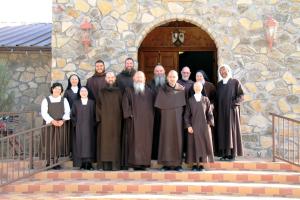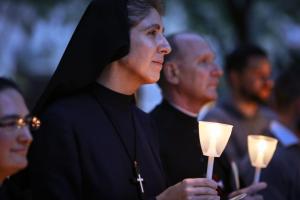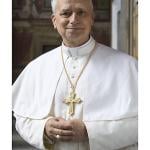In the Catholic Church, we have those people who have been set apart to imitate and follow Christ in a distinct way. These people live a consecrated life. They commit to giving everything (poverty) and doing anything (obedience) in God’s service, as a loving response to God’s love for them (chastity).
In his apostolic exhortation, Vita Consecrata, St. John Paul II wrote the following,
“We are all aware of the treasure which the gift of the consecrated life in the variety of its charisms and institutions represents for the ecclesial community. Together let us thank God for the Religious Orders and Institutes devoted to contemplation or the works of the apostolate, for Societies of Apostolic Life, for Secular Institutes and for other groups of consecrated persons, as well as for all those individuals who, in their inmost hearts, dedicate themselves to God by a special consecration. The Synod was a tangible sign of the universal extension of the consecrated life, present in the local Churches throughout the world. The consecrated life inspires and accompanies the spread of evangelization in the different parts of the world, where Institutes from abroad are gratefully welcomed and new ones are being founded, in a great variety of forms and expressions. Consequently, although in some parts of the world Institutes of Consecrated Life seem to be experiencing a period of difficulty, in other places they are prospering with remarkable vitality. This shows that the choice of total self-giving to God in Christ is in no way incompatible with any human culture or historical situation. Nor is the consecrated life flourishing within the Catholic Church alone. In fact, it is particularly vibrant in the monasticism of the Orthodox Churches, where it is an essential feature of their life. It is also taking root or re-emerging in the Churches and Ecclesial Communities, which originated in the Reformation, and is the sign of a grace shared by all of Christ’s disciples. This fact is an incentive to ecumenism, which fosters the desire for an ever fuller communion between Christians, “that the world may believe” (Jn 17:21).”
As noted from the above excerpt, there are different forms of consecrated life within the Catholic Church. Consecrated life can be classified as follows:
Evangelical Counsels

915. Christ proposes the evangelical counsels, in their great variety, to every disciple. The perfection of charity, to which all the faithful are called, entails for those who freely follow the call to consecrated life the obligation of practicing chastity in celibacy for the sake of the Kingdom, poverty and obedience. It is the profession of these counsels, within a permanent state of life recognized by the Church that characterizes the life consecrated to God.
916. The state of consecrated life is thus one way of experiencing a “more intimate” consecration, rooted in Baptism and dedicated totally to God. In the consecrated life, Christ’s faithful, moved by the Holy Spirit, propose to follow Christ more nearly, to give themselves to God who is loved above all and, pursuing the perfection of charity in the service of the Kingdom, to signify and proclaim in the Church the glory of the world to come.
Eremitic Life

920. Without always professing the three evangelical counsels publicly, hermits “devote their life to the praise of God and salvation of the world through a stricter separation from the world, the silence of solitude and assiduous prayer and penance.”
921. They manifest to everyone the interior aspect of the mystery of the Church, that is, personal intimacy with Christ. Hidden from the eyes of men, the life of the hermit is a silent preaching of the Lord, to whom he has surrendered his life simply because he is everything to him. Here is a particular call to find in the desert, in the thick of spiritual battle, the glory of the Crucified One
Consecrated Virgins and Widows


922. From apostolic times Christian virgins and widows, called by the Lord to cling only to Him with greater freedom of heart, body, and spirit, have decided with the Church’s approval to live in the respective states of virginity or perpetual chastity “for the sake of the Kingdom of heaven.”
923. “Virgins who, committed to the holy plan of following Christ more closely, are consecrated to God by the diocesan bishop according to the approved liturgical rite, are betrothed mystically to Christ, the Son of God, and are dedicated to the service of the Church.” By this solemn rite (Consecratio Virginum), the virgin is “constituted a sacred person, a transcendent sign of the Church’s love for Christ, and an eschatological image of this heavenly Bride of Christ and of the life to come.”
924. “As with other forms of consecrated life,” the order of virgins establishes the woman living in the world (or the nun) in prayer, penance, service of her brethren, and apostolic activity, according to the state of life and spiritual gifts given to her. Consecrated virgins can form themselves into associations to observe their commitment more faithfully.
Religious Life

925. Religious life was born in the East during the first centuries of Christianity. Lived within institutes canonically erected by the Church, it is distinguished from other forms of consecrated life by its liturgical character, public profession of the evangelical counsels fraternal life led in common, and witness given to the union of Christ with the Church.
926. Religious life derives from the mystery of the Church. It is a gift she has received from her Lord, a gift she offers as a stable way of life to the faithful called by God to profess the counsels. Thus, the Church can both show forth Christ and acknowledge herself to be the Savior’s bride. Religious life in its various forms is called to signify the very charity of God in the language of our time.
927. All religious, whether exempt or not, take their place among the collaborators of the diocesan bishop in his pastoral duty. From the outset of the work of evangelization, the missionary “planting” and expansion of the Church require the presence of the religious life in all its forms. “History witnesses to the outstanding service rendered by religious families in the propagation of the faith and in the formation of new Churches: from the ancient monastic institutions to the medieval orders, all the way to the more recent congregations.”
Secular Institutes

928. “A secular institute is an institute of consecrated life in which the Christian faithful living in the world strive for the perfection of charity and work for the sanctification of the world especially from within.”
929. By a “life perfectly and entirely consecrated to [such] sanctification,” the members of these institutes share in the Church’s task of evangelization, “in the world and from within the world,” where their presence acts as “leaven in the world.” “Their witness of a Christian life” aims “to order temporal things according to God and inform the world with the power of the gospel.” They commit themselves to the evangelical counsels by sacred bonds and observe among themselves the communion and fellowship appropriate to their “particular secular way of life.”
Societies of Apostolic Life

930. Alongside the different forms of consecrated life are “societies of apostolic life whose members without religious vows pursue the particular apostolic purpose of their society, and lead a life as brothers or sisters in common, according to a particular manner of life, strive for the perfection of charity through the observance of the constitutions. Among these there are societies in which the members embrace the evangelical counsels” according to their constitutions.
“For many are called, but few are chosen” – Matthew 22:14













